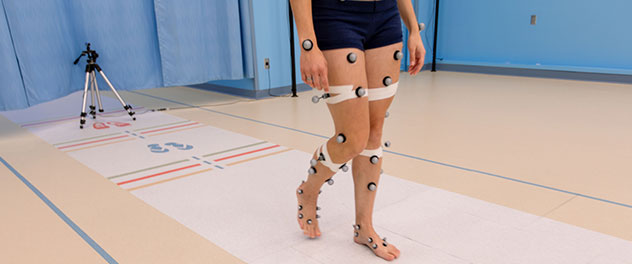 Advancing musculoskeletal care
Advancing musculoskeletal care
Building on a long history of patient-driven innovation, our physicians and scientists continue to push the boundaries of discovery for better diagnosis and care, such as state-of-the-art gait studies in the Motion Analysis Laboratory of Kenton R. Kaufman, Ph.D., P.E.
Overview
For nearly a century, the Division of Orthopedic Surgery Research at Mayo Clinic has worked to improve outcomes and quality of life for both adult and pediatric patients with musculoskeletal disorders.
Once problems are identified in the clinic, our physicians and scientists take them to the laboratory bench for study, and the results are then translated back into clinical practice, where they directly benefit patients. Our investigators secure research grants to support their work, conduct clinical trials, run basic research laboratories and train future generations of researchers, and many also provide patient care.
In the Division of Orthopedic Surgery Research, we're pushing scientific boundaries to find more opportunities to improve the well-being of our patients. Advances in molecular medicine, genomics and proteomics allow us to investigate revolutionary new treatments for conditions that affect the musculoskeletal system, including arthritis, cancer, sports injuries, traumatic amputations, and bone and joint problems.
Musculoskeletal diseases and musculoskeletal trauma affect hundreds of millions of people around the world and cost billions of dollars to treat, with visits to emergency rooms, medical offices and specialists.
Our commitment to do better for our patients isn't new. In 1927, a Mayo Clinic orthopedist was the first to describe the pathological events that lead to compartment syndrome. In the 1940s, another orthopedist was among the first to design metal plates to fix fractures securely. In 1970, a Mayo Clinic orthopedist was the first in the United States to implant an artificial hip joint. A joint registry started decades ago provides a wealth of information that informs research and treatment still today. Mayo Clinic orthopedists have also pioneered treatments for bone cancer, complex wrist injuries and injuries to children's growing bones, and have developed artificial joints for every major joint.
Today, some of our research focus areas include:
- Regeneration of bone and cartilage.
- Motion analysis.
- Scoliosis.
- Tissue engineering.
- Elbow disorders.
As part of the Department of Orthopedic Surgery, our research division leverages the wealth of expertise offered by a multidisciplinary faculty, fostering a collaborative environment that extends the scope of orthopedic research. Together, we continue the drive to expand and enhance clinical, basic and translational research activities.